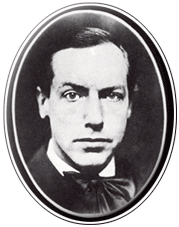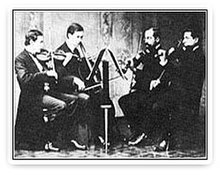Karl Klingler
Karl Klingler (* December 7, 1879 in Strasbourg , then German Empire ; † March 18, 1971 in Munich ) was a German violin virtuoso , concert master , composer , music teacher and university teacher .
Life
Karl Klingler was the fifth of six children of the Strasbourg theater orchestra violist Theodor Klingler and Marie Elisabeth Klingler, nee Christian. The five-year-old learned to play the violin from his father and then from his colleague at the Strasbourg Conservatory, Heinrich Schuster. The seventeen-year-old then studied violin with Joseph Joachim and composition with Max Bruch and Robert Kahn at the Berlin State University of Music and won the Mendelssohn State Prize for composition at the age of 19 .
In 1904 he became 2nd concertmaster with the Berlin Philharmonic under Arthur Nikisch . In addition, he was accepted as a violist in the famous Joachim Quartet of his former teacher, which was founded in 1869 , which meant him a high level of recognition. In addition to his concert activities, he composed songs, chamber music and a violin concerto in E major, which he performed with the Berlin Philharmonic in 1907.
In 1910 he was appointed Royal Prussian Professor of the violin at the State University of Music in Berlin , which made him the successor to Joseph Joachim. He also managed to acquire a Stradivarius - the De Barreau from 1714 - that had been in Joachim's possession. In 1911, his performance of Beethoven's Triple Concerto with Arthur Williams and Artur Schnabel in the American music magazine The Musical Times and Singing-class Circular received ardent admiring reviews.
During the First World War he was initially employed as a soldier, but later also as a musician for cultural troop support with his newly formed string quartet. He gave concerts a. a. at the British royal court and in the Vatican , but also in front of workers in factory halls. During the war he married the wealthy, piano-playing Margarethe von Gwinner, daughter of the banker and manor Arthur von Gwinner . He had four children with her.
In 1920 a young Japanese named Shinichi Suzuki came to see him and asked for private lessons, which he then enjoyed with him for eight years: the first four years mainly concerts and sonatas, the next four years chamber music. The Suzuki method , which is now widespread worldwide, was influenced by Karl Klingler.
During National Socialism in 1936, Klingler resisted the iconoclasm at his university, to which the bust of his highly revered - Jewish - teacher Joseph Joachim fell victim. He then lost his professorship, was banned from performing in Germany and went to Switzerland for a few months. After his return he emigrated and devoted himself to composing. Among other things, a large work for choir, a solo part and piano was created. In exchanging ideas with his friend Max Planck , he also dealt with certain geometric problems.
After the Berlin house had become uninhabitable due to bombs, he and his family moved to the Krumke manor in Altmark, which his wife had inherited and transferred to him . He only escaped the execution of an already existing arrest warrant from the National Socialists because American troops had already occupied the palace. This was followed by the takeover of the manor by the Soviet occupying power and expropriation as part of the GDR land reform . The family moved to Hanover and in 1949 to Munich . There he worked as a writer on musical topics such as the Rode Caprices or Bach's solo sonatas , created smaller compositions and arrangements, and continued to deal with geometry. Klingler had been a member of the Munich Casual Society since 1950 . Until shortly before his death at the age of 92 he made music every day: sonatas with his wife and chamber music with his children, friends and acquaintances.
The Klingler Quartet
The Klingler Quartet , founded by Karl Klingler in 1905 , initially consisted of himself as first violinist, the Russian Josef Rywkind as 2nd violinist, Klingler's older brother Fridolin as violist and Arthur Williams, a Briton from Wales , on the cello, who played the cello to his teacher Robert Hausmann , who had played in the Joachim Quartet for many years, followed in the game down to the smallest detail and thus, together with Klingler, ensured the continuation of the Joachim Quartet's music and sound tradition. Because of the First World War, the quartet, which consisted of citizens whose countries were at war with one another, had to disband.
Klingler later continued the tradition of the Klingler Quartet with Richard Heber as 2nd violinist. Cellist was initially Max Baldner , and from 1926 Francesco von Mendelssohn . How the style and sound of the Joachim Quartet, once praised as the best string quartet in the world, can best be understood from the recordings that Karl Klingler made with this quartet, because he was also considered the legitimate successor with his quartet Joachims.
Even in the era of National Socialism, a “non-Aryan” sat at the cello again: in 1934 the Klingler Quartet played with the Jewish cellist Ernst Silberstein at the invitation of the President Paul von Hindenburg and in the presence of Adolf Hitler . In 1936 Klingler refused to give in to pressure from the National Socialists and to exchange Silberstein for an "Aryan" cellist. Silberstein emigrated, and Klingler resignedly dissolved the quartet, which had meanwhile become world-famous.
The new beginning of the quartet after the war with Agnes Ritter, Friedrich Hausmann and Otto Garvens could no longer follow on from the great tradition; after all, Klingler had meanwhile also reached retirement age.
Karl Klingler Foundation
In 1979, the Karl Klingler Foundation was set up to promote string quartets and to promote early musical education in the spirit of Shinichi Suzuki .
Suzuki's principles are that all children can learn to play the violin 1. through an early start, 2. through a better method, and 3. through a better teacher, and further that the service of humanity is the highest calling and the highest goal artistic endeavors, the ennobling of society, found its way into the foundation's goals.
At the first Karl Klingler competitions for string quartet in Hanover, a. a. The Cherubini Quartet, the Stuttgart and Mannheim String Quartet from Germany, the Guadagnini and Fairfield Quartet from Great Britain, the Voces Quartet from Romania, and scholarships were awarded to the German Auryn Quartet and the Polish Voces Academia Quartet. After a break of several years, the Karl Klingler Competition took place for the first time in 1998 at the place of work of the namesake, the current “Hanns Eisler” University of Music in Berlin , and the first winners there were the German Kuss Quartet and the two French Quatuors Johannes and Diotima.
Works (selection)
- Violin Concerto in E major (1907)
- Sonata in D minor - viola and piano
- Sonata in A minor - violoncello and piano
- Serenade in G major, Op. 141a - violin and viola
- Piano quintet in E flat major
- String quartet in F minor (1904, ms)
- String quartet in F sharp minor
- Incidental music for the Chinese legend by Albrecht Haushofer (private print of a piano reduction 1954)
Fonts:
- About the basics of violin playing
- From the rhythm
- From the musical idea and its representation
Discography
- Violin Concerto in E major ( Ulf Hoelscher , Bavarian Radio Symphony Orchestra , Volker Schmidt-Gertenbach ), Sonata for viola and piano in D minor (Karl Klingler (viola) and Michael Raucheisen (piano)). MDG 1979 / MDG Archive 2019.
literature
- Werner Bollert: Klingler, Karl. In: New German Biography (NDB). Volume 12, Duncker & Humblot, Berlin 1980, ISBN 3-428-00193-1 , p. 96 ( digitized version ).
- James Lesley Creighton, James Creighton: Discopaedia of the Violin 1889–1971 . University of Toronto Press, Toronto 1974, ISBN 0-8020-1810-6 .
- Tully Potter: Klingler, Karl. In: Ludwig Finscher (Hrsg.): The music in past and present . Second edition, personal section, volume 10 (Kemp - Lert). Bärenreiter / Metzler, Kassel et al. 2003, ISBN 3-7618-1120-9 ( online edition , subscription required for full access)
- Robin Stowell (Ed.): The Cambridge Companion to the String Quartet . Cambridge University Press, Cambridge 2003, ISBN 0-511-07479-4 .
- Hugo Riemann , Wilibald Gurlitt , Hans Heinrich Eggebrecht , Carl Dahlhaus (eds.): Riemann Musiklexikon : Supplementary volume 1. Schott, Mainz 1972.
- Otto Weinreich : Beethoven evening by the Klingler Quartet . In: ders .: Selected Writings IV , Ed. Günther Wille. John Benjamin Publishing Company, Amsterdam 1975, ISBN 90-6032-060-3 , pp. 311-313 ( limited preview in Google book search).
Web links
- Works by and about Karl Klingler in the catalog of the German National Library
- Karl Klingler in the Munzinger archive ( beginning of article freely available)
- Tobias Knickmann: Karl Klingler in the dictionary of persecuted musicians of the Nazi era (LexM)
Individual evidence
- ^ Anton Würz: Klingler, Karl. In: Friedrich Blume (Hrsg.): The music in past and present (MGG). First edition, Volume 16 (Supplement 2: Eardsen - Zweibrücken). Bärenreiter / Metzler, Kassel et al. 1976, DNB 550439609 , Sp. 1002–1003 (= Digital Library Volume 60, pp. 42.225–42.227)
- ↑ Albrecht Roeseler: Introduction to: Karl Klingler: About the basics of violin playing . Olms, Hildesheim 1990, p. VII.
- ↑ Identification and Information about old stringed instruments . Cozio.com
- ↑ Joachim's Instruments
- ^ The Musical Times and Singing-class Circular , 1911, p. 466.
- ^ Kerstin Wartberg: Shinichi Suzuki. Music education pioneer. German Suzuki Institute, 2009, accessed May 19, 2016 .
- ↑ a b biography. (No longer available online.) Karl Klingler Foundation, archived from the original on November 8, 2014 ; Retrieved May 19, 2016 . Info: The archive link was inserted automatically and has not yet been checked. Please check the original and archive link according to the instructions and then remove this notice.
- ↑ Casual society: A hundred and fifty years Casual society Munich from 1837 to 1987 . University printing and publishing house Dr. C. Wolf and Son, Munich 1987, 159 pages
- ↑ Klingler Quartet. Karl Klingler Foundation, accessed on May 19, 2016 .
- ^ A b Tully Potter: The Concert Explosion and The Age of Recording . In: Robin Stowell: The Cambridge Companion to the String Quartet . Cambridge 2003, p. 69.
- ^ Hugo Riemann, Wilibald Gurlitt, Hans Heinrich Eggebrecht, Carl Dahlhaus (eds.): Riemann-Musiklexikon, supplementary volume . Schott, Mainz 1959.
- ↑ a b Otto Weinreich : Selected Writings IV . P. 311 ff. ( Limited preview in Google Book search).
- ↑ Activities. Karl Klingler Foundation, accessed on May 19, 2016 .
- ↑ Peter Uehling: The rhythm takes on plastic form. Final concert of the Karl Klingler Competition for String Quartet . In: Berliner Zeitung , April 11, 1998.
- ↑ Karl Klingler Foundation awards prizes in the music competition. In: klassik.com. April 14, 1998, accessed November 28, 2008 .
- ↑ Karl Klingler: About the basics of violin playing and legacy writings . Ed .: Marianne M. Klingler, Agnes Ritter. 1990, ISBN 3-487-09298-0 .
| personal data | |
|---|---|
| SURNAME | Klingler, Karl |
| BRIEF DESCRIPTION | German violinist and composer |
| DATE OF BIRTH | December 7, 1879 |
| PLACE OF BIRTH | Strasbourg , German Empire |
| DATE OF DEATH | March 18, 1971 |
| Place of death | Munich |


